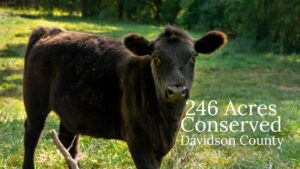
by Ruth Ann Grissom
December 13, 2017
 The dry weather this fall hasn’t been kind to anyone wanting to paddle the Uwharrie River, but the crisp, sunny days have been ideal for hunting and hiking. Our favorite route takes us through native grasslands, a stand of shortleaf pines and a mature hardwood forest. At every transition, there are scruffy margins teeming with beggar’s lice (Desmodium sp.) and cockleburs (Xanthium sp.).
The dry weather this fall hasn’t been kind to anyone wanting to paddle the Uwharrie River, but the crisp, sunny days have been ideal for hunting and hiking. Our favorite route takes us through native grasslands, a stand of shortleaf pines and a mature hardwood forest. At every transition, there are scruffy margins teeming with beggar’s lice (Desmodium sp.) and cockleburs (Xanthium sp.).
Both can be a chore to remove from clothing, especially loose knits like thick wool socks. Laundering can make matters worse – a few inevitably migrate to places you’d rather they didn’t. Instead of picking them one by one, try pulling out a pocket knife. While wearing the garment, hold the blade almost parallel to the fabric and swipe. This technique is most effective on a tight weave like denim or a slick nylon blend.
Despite this nuisance, hunters ought to welcome the sight of beggar’s lice clinging to their camo. According to the Quality Deer Management Association (https://www.qdma.com/know-deer-plants-beggars-lice), these little seeds are just as nutritious as the highly touted soybean. Also known as tick trefoil, they’re a favorite browse of white tailed deer and game birds such as turkey and bobwhite quail. Think of this this way: if you aren’t picking up beggar’s lice, you aren’t spending time in high quality habitat.
 Wildflower enthusiasts will also find plenty to appreciate. The foliage is arranged along thin arching stalks, groups of three slender leaflets. Some species bear a white watermark. It’s easy to see they belong to the legume family. Blooming in late summer and well into fall, they look delicate and fresh among the asters, sunflowers and goldenrods also found in early successional habitat. Hummingbirds are drawn to the lavender pea-like flowers, and the plants serve as larval host for butterflies such as the silver-spotted skipper and the hoary edge (which strikes me as an awesome name for a rock band).
Wildflower enthusiasts will also find plenty to appreciate. The foliage is arranged along thin arching stalks, groups of three slender leaflets. Some species bear a white watermark. It’s easy to see they belong to the legume family. Blooming in late summer and well into fall, they look delicate and fresh among the asters, sunflowers and goldenrods also found in early successional habitat. Hummingbirds are drawn to the lavender pea-like flowers, and the plants serve as larval host for butterflies such as the silver-spotted skipper and the hoary edge (which strikes me as an awesome name for a rock band).
The fruits soon follow, often hanging in chains of three or four triangular seeds. In the world of botany, this is known as a loment. It’s characteristic of many legumes. Instead of being contained inside a pod that eventually splits open, the seeds are connected and break apart at maturity. In my experience, they seem as sticky when green as when they ripen to brown.
The spiky football-shaped seedpods of cockleburs look like medieval weapons. Even though they were once relished by the extinct Carolina parakeet, domestic animals would do well to avoid them. If ingested, they can be toxic to horses and cows. Dogs can suffer mightily when the prickly seeds become entangled in their fur.
During a recent trip to the Uwharries, my sister’s Pomeranian was something of a cocklebur magnet. He picked one up as he romped with my short-haired Chihuahua and relatively sleek Jack Russell. We’re still mystified as to how he got it – they were in a groomed backyard. I imagine his poufy fur beckoning to cockleburs far and wide. We quickly realized there was no way to disentangle it from his undercoat. Scissors would be required. Rather than risk a puncture wound, we left the task to a professional.
Before they set seed, the plants themselves are really quite beautiful. They have large, jagged, light green leaves set off fetchingly by dark pink stems. They look somewhat tropical. An enterprising plantsman ought to develop a cultivar for the landscape trade. If gardeners can embrace the toxic castor bean plant for use in the mixed border, why not cockleburs?
In a roundabout way, cockleburs have proven exceedingly helpful to humans. They are reportedly the inspiration for Velcro. In the 1940s, Swiss engineer George de Mestral and his dog returned from a hunt covered with cockleburs. Irritated but intrigued, he studied them under a microscope and discovered hundreds of tiny hooks that allow them to attach to fur and fabric. Based on this technology, he developed a hook and loop system and named it for the French words for velvet (velour) and hook (crochet).
As with many of life’s nuisances, the trick to appreciating beggar’s lice and cockleburs is to reframe and see them from a different perspective.